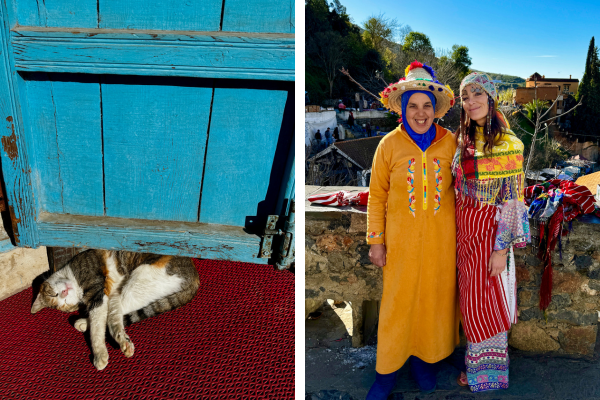
Chefchaouen: Discovering the Magic of Morocco's Blue City
Some journeys lead to the most magical moments, and traveling to Chefchaouen is one of them. The beautiful and relatively untouched city, known as the Blue Pearl of Morocco, is set amongst the stunning Rif Mountains and takes a 2-2.5 hour drive from Tangier. Many travelers, including myself, are drawn to the town's blue-washed buildings and streets, without expecting all of the magic within the history, culture, and people.
My journey to Chefchaouen was in early January, when the streets were fairly empty (the high season runs from March to May and September to November). My first impression was the fresh, crisp air and the calmness of a slow-paced life. After a short taxi ride into the city's heart, the quiet streets called me to wander and wind down every alley, stopping every 10-15 feet to take a photo. The town is a photography backdrop dream, so aesthetically unique with endless photo opportunities!

Some of my favorite moments happened during my walk out of the Medina to witness Ras El Maa. This spring comes from the mountains and serves as a vital water source for Chefchaouen. Set next to the spring, some carts offer fresh orange or pomegranate juice, made with love and care by vendors that peel and prepare the fruit so quickly you'll be just as mesmerized by the process as you are by the taste of the juice. After sitting next to the spring, which makes an ideal spot for sipping freshly squeezed juice, I was lucky enough to meet a local woman who took an interest in showing me the traditional clothing of the Berber culture. Without expectation of any payment, she kindly dressed me in authentic attire. I'll never forget how she smiled after I was fully fitted in the colorful clothing, a style unique to the region. Her warm heart and kind gesture created a fairytale moment, a memory I will always cherish.
I hope you have a chance to visit this gorgeous town! A special thank you to Eco Linko for planning the perfect Chefchaouen visit, and to Hotel dar Chefchaouen for the beautiful stay and scrumptious breakfast.
A Few Things to Expect in Chefchaouen:
Language: Arabic is the official language, but you’ll find most locals speak French and some English, especially in tourist areas.
Currency: Morocco uses dirhams; one US dollar will get you about 10-11. It is best to carry cash, as most businesses prefer it, and the vendors in the market only accept this form of payment. Expect to haggle in the markets (paying around ⅓ of the original price).
Climate: Chefchaouen experiences all seasons, so for mild temperatures, the best time to visit is spring (March to May) or autumn (September to November). It is beautiful all year, but temperatures can be cool at night in the other months.
December to February: average highs 50-59 degrees F, with lows 32-41degrees F
March to May: average highs 59-77 degrees F, and lows 41-50 degrees F
June to August: average highs 77-86 degrees F, with lows 59-68 degrees F
September to November: average highs 59-77°F, with lows 41-59 degrees F
Clothing: Morocco is a Muslim country, so you'll quickly notice some cultural differences. Packing lightweight, loose-fitting clothing that covers your shoulders and knees (think maxi skirts and summer scarves) while in the Medina or other traditional areas shows respect to the culture. Nothing goes in the city, the desert, and most modern hotels.
Culture: Respect local customs by dressing modestly, especially in more traditional areas.
Getting There: it’s a 2.5 hour drive from Tangier, which can be reached by fast train from Casablanca.
Good to Know: The town is small and pedestrian-friendly, making it easy to explore on foot. Wear comfortable shoes, as some streets can be steep. Accessibility is limited. Keep in mind that the streets are cobblestone, and those in the city center, where the riads are located, is too small for taxis to drive down. Packing light is recommended to avoid carrying heavy suitcases.
If you can, align your visit with local festivals, a special treat of traditional music, dance, and crafts.
It’s a safe place to visit, but always be aware of your belongings.
xx, Kam